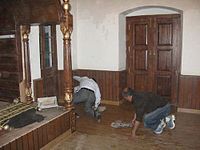A gurdwara is a place of assembly and worship for Sikhs. Sikhs also refer to gurdwaras as Gurdwara Sahib. People from all faiths are welcomed in gurdwaras. Each gurdwara has a Darbar Sahib where the current and everlasting guru of the Sikhs, the scripture Guru Granth Sahib, is placed on a takhat in a prominent central position. Any congregant may recite, sing, and explain the verses from the Guru Granth Sahib, in the presence of the rest of the congregation.
The following outline is provides an overview of Sikhism, or Sikhi.
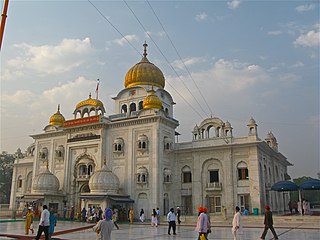
Gurudwara Bangla Sahib is one of the most prominent Sikh gurdwaras, or Sikh house of worship, in Delhi, India, and known for its association with the eighth Sikh Guru, Guru Har Krishan, as well as the holy pond inside its complex, known as the "Sarovar." It was first built as a small shrine by Sikh General Sardar Baghel Singh in 1783, on the bungalow donated by king Raja Jai Singh of Amer, who supervised the construction of nine Sikh shrines in Delhi in the same year, during the reign of Mughal Emperor, Shah Alam II.
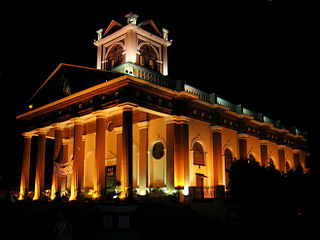
Kapurthala is a city in Punjab state of India. It is the administrative headquarters of Kapurthala District. It was the capital of the Kapurthala State, a princely state in British India. The aesthetic mix of the city with its prominent buildings based on French and Indo-Saracenic architecture self-narrate its princely past. It is also known as city of Palaces & Gardens. According to the 2011 Census, Kapurthala is the least populated city in India.

Anandpur Sahib, sometimes referred to simply as Anandpur, is a city in Rupnagar district (Ropar), on the edge of Shivalik Hills, in the Indian state of Punjab. Located near the Sutlej River, the city is one of the most sacred places in Sikhism, being the place where the last two Sikh Gurus, Guru Tegh Bahadur and Guru Gobind Singh, lived. It is also the place where Guru Gobind Singh founded the Khalsa Panth in 1699. The city is home to Takhat Sri Kesgarh Sahib, Third of the five Takhts in Sikhism.

Guru Nanak Dev Ji Gurpurab, also known as Guru Nanak's Prakash Utsav, celebrates the birth of the first Sikh guru, Guru Nanak. One of the most celebrated and important Sikh gurus and the founder of Sikhism, Guru Nanak Dev is highly revered by the Sikh community. This is one of the most sacred festivals in Sikhism, or Sikhi. The festivities in the Sikh religion revolve around the anniversaries of the 10 Sikh Gurus. These Gurus were responsible for shaping the beliefs of the Sikhs. Their birthdays, known as Gurpurab, are occasions for celebration and prayer among the Sikhs.
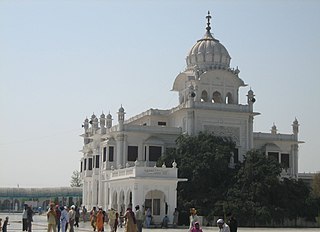
Sultanpur Lodhi is a city and a Municipal Council in the Kapurthala district in the Indian state of Punjab. The town is named after its founder, Bahlol Lodhi, the future Sultan of Delhi who renamed the town in 1443 C.E. during his time as governor of Punjab, and has also been mentioned in the Ain-e-Akbari. Sultanpur Lodhi is located on the south bank of a seasonal rivulet called Kali Bein, which runs 6 miles (9.7 km) north of the intersection of Beas and Sutlej Rivers, two of the Five Rivers of Punjab. The word "Punj - ab" literally means "five rivers - land".

Nanakpanthis is a Sikh sect which refers to followers of the teachings of Guru Nanak (1469-1539), the foundational guru of a spiritual community natively known as Nanakpanth while known world-wide as Sikhism. Nanakpanth is an open frontier that references strongly an early Sikh community. Nanakpanthi signifies any person, regardless of any religious affiliation, who follows Guru Nanak and believes in his teachings of Universal brotherhood, Truth, Love, Tolerance, Compassion and most importantly Oneness of one single formless Waheguru.

Manikaran is located in the Parvati Valley on river Parvati, northeast of Bhuntar in the Kullu District of Himachal Pradesh. It is at an altitude of 1760 m and is located 4 km from Kasol, about 45 km from Kullu and about 35 km from Bhuntar.

Gurdwara Nanak Shahi is the principal Sikh Gurdwara in Dhaka, Bangladesh. It is located at the campus of the University of Dhaka and considered to be the biggest of the 9 to 10 Gurdwaras in the country. The Gurudwara commemorates the visit of Guru Nanak (1506–1507). It is said to have been built in 1830. The present building of the Gurdwara was renovated in 1988–1989. The parkarma verandah had been constructed on all four sides of the original building to provide protection.
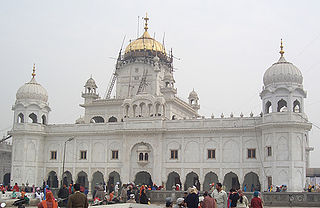
Gurdwara Dukh Nivaran Sahib is situated in what used to be the village of Lehal, now part of Patiala city.

Gurudwara Paonta Sahib, is a noted Gurudwara in Paonta Sahib, District of Sirmaur, Himachal Pradesh.

Gurdwara Darbar Sahib Kartarpur, also called Kartarpur Sahib, is a gurdwara in Kartarpur, located in Shakargarh, Narowal District, in the Punjab province of Pakistan. It is built on the historic site where the founder of Sikhism, Guru Nanak, settled and assembled the Sikh community after his missionary travels and lived for 18 years until his death in 1539. It is one of the holiest sites in Sikhism, alongside the Golden Temple in Amritsar and Gurdwara Janam Asthan in Nankana Sahib.

Hazur Sahib, also known as Takht Sachkhand Sri Hazur Abchalnagar Sahib, is one of the five takhts in Sikhism. The gurdwara was built between 1832 and 1837 by Maharaja Ranjit Singh (1780–1839). It is located on the banks of the Godavari River at the city of Nanded in the state of Maharashtra, India.
Gurdwara Nagiana Sahib is a Gurudwara, or holy Sikh shrine, located in Udoke, a small village near Batala in Punjab, India. The shrine was built by the Sikh saint Sant Baba Chuggat Singh Ji, who served as the first official Sewadar (volunteer) of the shrine.

Nanakmatta is a historical town named after the Sikh pilgrimage site, Gurdwara Nanak Mata Sahib, in the state of Uttarakhand in India. Sikh tradition records that the site was once called Gorakhmata, a centre of Siddh-jogis named after the founder of their order, Gorakhnath, at the distance of 30 miles from Reetha sahib. In the Siddh-Gost in Guru Granth Sahib, the story of Guru Nanak on his first udasi is told, wherein he had a long discourse with siddhas on matters of religion and metaphysics. Tradition says that the place was renamed Nanakmatta to perpetuate the memory of Guru's visit. The town is associated with Guru Nanak Dev and Guru Hargobind. It is situated on the bank of Deoha stream, which has since been dammed into a reservoir named Nanak Sagar. The Gurudwara is located 15 kilometres west of Khatima Railway Station on road to Tanakpur. The holy shrine is near the town of Sitarganj. It is one of three Sikh Holy places in the state, with others being Gurdwara Hemkunt Sahib and Gurudwara Reetha Sahib.

Guru Nanak Jhira Sahib is a Sikh historical shrine situated in Bidar, Karnataka. Gurdwara Nanak Jhira Sahib was built in 1948 and is dedicated to the first Sikh guru, Guru Nanak. Bidar has a very long association with Sikhism as this is the home town of Bhai Sahib Singh, one of the Panj Pyare, who offered to sacrifice their heads and were later baptised as the first members of the Khalsa.
Sajjana is a village in Hoshiarpur tehsil of Hoshiarpur district in Punjab, India.

Baba Nanak Shrine, a Sikh Gurdwara in Baghdad, Iraq, which was rediscovered by Sikh soldiers during World War I and was repaired and rebuilt during World War II, by Sikh soldiers again, existed till 2003 in somewhat good shape.
The Guru Nanak Darbar is a Sikh gurdwara at Jebel Ali Village in Dubai, founded in 2012 to serve over 50,000 Sikh residents in the emirate. The community-run gurdwara is the first official Sikh temple in the GCC region and the Middle East, and it was established by Surender Singh Kandhari, a resident of Dubai since 1976.





